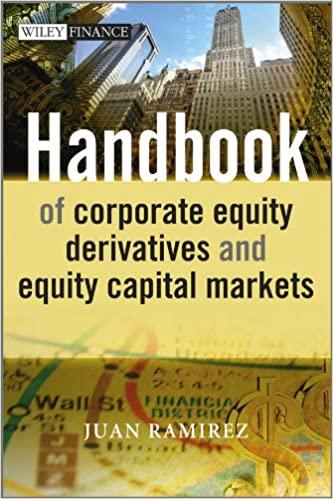Question
Phoenix Company common stock is currently selling for $20 per share. Security analysts at Smith Blarney have assigned the following probability distribution to the price
Phoenix Company common stock is currently selling for $20 per share. Security analysts at Smith Blarney have assigned the following probability distribution to the price of (and rate of return on) Phoenix stock one year from now:
| Price | Rate of Return | Probability |
| $16 | -20% | 0.25 |
| 20 | 0% | 0.30 |
| 24 | +20% | 0.25 |
| 28 | +40% | 0.20 |
Assuming that Phoenix is not expected to pay any dividends during the coming year, determine the expected rate of return on Phoenix Stock.
| a. | 8% |
| b. | 0% |
| c. | 10% |
| d. | 40% |
8. An investor plans to invest 75 percent of her funds in the common stock of Gamma Industries and 25 percent in Epsilon Company. The expected return on Gamma is 12 percent and the expected return on Epsilon is 16 percent. The standard deviation of returns for Gamma is 8 percent and for Epsilon is 12 percent. The correlation between the returns for Gamma and Epsilon is +0.8. Determine the expected return on the investor's portfolio.
| a. | 14% |
| b. | 12% |
| c. | 13% |
| d. | 9% |
9. Compute the risk premium for the stock of Omega Tools if the risk-free rate is 6%, the expected market return is 12%, and Omega's stock has a beta of .8.
| a. | 10.8% |
| b. | 4.8% |
| c. | 48.0% |
| d. | 16.8% |
10. Don has $3,000 invested in AT&T with an expected return of 11.6 percent; $10,000 in IBM with an expected return of 12.8 percent; and $6,000 in GM with an expected return of 12.2 percent. What is Don's expected return on his portfolio?
| a. | 12.42% |
| b. | 12.20% |
| c. | 11.81% |
| d. | Cannot be determined |
11. What is the risk premium of a stock if the risk-free rate is 3%, the return in the market is 12% and beta is 1.1?
| a. | 12.9% |
| b. | 13.2% |
| c. | 9.9% |
| d. | 15.1% |
12. What is the required rate of return on a stock that has a beta of 2.3, the market risk premium is 12% and the risk-free rate is 3%?
| a. | 15.7% |
| b. | 12.8% |
| c. | 21.9% |
| d. | 30.6% |
13. Systematic risk is also referred to as:
| a. | diversifiable risk |
| b. | economic risk |
| c. | nondiversifiable risk |
| d. | not relevant |
Step by Step Solution
There are 3 Steps involved in it
Step: 1

Get Instant Access to Expert-Tailored Solutions
See step-by-step solutions with expert insights and AI powered tools for academic success
Step: 2

Step: 3

Ace Your Homework with AI
Get the answers you need in no time with our AI-driven, step-by-step assistance
Get Started


